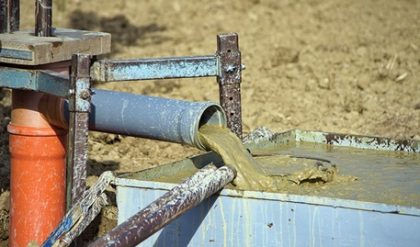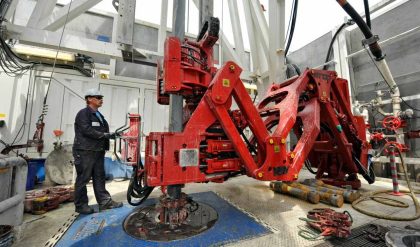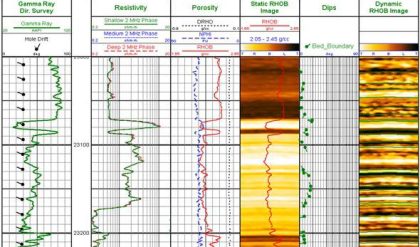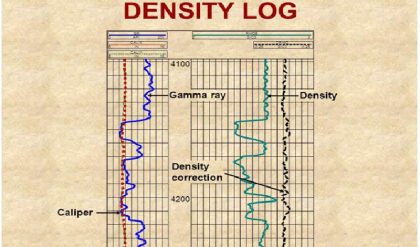A core sample is a cylindrical section of (usually) a naturally-occurring substance. Most core samples are obtained by drilling with special drills into the substance, such as sediment or rock, with a hollow steel tube, called a core drill. The hole made for the core sample is called the “core hole”. A variety of core samplers exist to sample different media under different conditions. More continue to be invented on a regular basis. In the coring process, the sample is pushed more or less intact into the tube. Removed from the tube in the laboratory, it is inspected and analyzed by different techniques and equipment depending on the type of data desired.
Core samples can be taken to test the properties of manmade materials, such as concrete, ceramics, some metals and alloys, especially the softer ones. Core samples can also be taken of living things, including human beings, especially of a person’s bones for microscopic examination to help diagnose diseases.
Methods

Granitic rock core from Stillwater igneous complex, Montana (from a spoil pile).
The composition of the subject materials can vary from almost liquid to the strongest materials found in nature or technology, and the location of the subject materials can vary from on the laboratory bench to over 10 km from the surface of the Earth in a borehole. The range of equipment and techniques applied to the task is correspondingly great. Core samples are most often taken with their long axis oriented roughly parallel to the axis of a borehole, or parallel to the gravity field for the gravity-driven tools. However it is also possible to take core samples from the wall of an existing borehole. Taking samples from an exposure, albeit an overhanging rock face or on a different planet, is almost trivial. (The Mars Exploration Rovers carry a Rock Abrasion Tool, which is logically equivalent to the “rotary sidewall core” tool described below.)
Some common techniques include:
· gravity coring, in which the core sampler is dropped into the sample, usually the bed of a water body, but essentially the same technique can also be done on soft materials on land. The penetration forces, if recorded, give information about the strength of different depths in the material, which may be the only information required, with samples as an incidental benefit. This technique is common in both civil engineering site investigations (where the techniques tend towards into pile driving) and geological studies of recent aquatic deposits. The low strength of the materials penetrated means that cores have to be relatively small.
· vibracoring, in which the sampler is vibrated to allow penetration into thixotropic media. Again, the physical strength of the subject material limits the size of core that can be retrieved.
· drilling exploration diamond drilling where a rotating annular tool backed up by a cylindrical core sample storage device is pressed against the subject materials to cut out a cylinder of the subject material. A mechanism is normally needed to retain the cylindrical sample in the coring tool. Depending on circumstances, particularly the consistency and composition of the subject materials, different arrangements may be needed within the core tools to support and protect the sample on its way to surface; it is often also necessary to control or reduce the contact between the drilling fluid and the core sample, to reduce changes from the coring process. The mechanical forces imposed on the core sample by the tool frequently lead to fracture of the core and loss of less-competent intervals, which can greatly complicate interpretation of the core. Cores can routinely be cut as small as a few millimeters in diameter (in wood, for dendrochronology) up to over 150 millimeters in diameter (routine in oil exploration). The lengths of samples can range from less than a meter (again, in wood, for dendrochronology) up to around 200 metres in one run, though 27 to 54 meters is more usual (in oil exploration), and many runs can be made in succession if “quick look” analysis in the field suggests that the zone of interest is continuing.
· percussion sidewall coring uses robust cylindrical “bullets” explosively propelled into the wall of a borehole to retrieve a (relatively) small, short core sample. These tend to be heavily shattered, rendering porosity/ permeability measurements dubious, but are often sufficient for lithological and micropalaeontological study. Many samples can be attempted in a single run of the tools, which are typically configured with 20 to 30 “bullets” and propulsive charges along the length of a tool. Several tools can often be ganged together for a single run. The success rates for firing a particular bullet, it penetrating the borehole wall, the retention system recovering the bullet from the borehole wall, and the sample being retained in the bullet are all relatively low, so it is not uncommon for only half the samples attempted to be successful. This is an important consideration in planning sample programmes.
· rotary sidewall coring where a miniaturised automated rotary drilling tool is applied to the side of the borehole to cut a sample similar in size to a percussion sidewall core (described above). These tend to suffer less deformation than percussion cores. However the core-cutting process takes longer and jams are common in the ancillary equipment which retrieves the sample from the drill bit and stores it within the tool body.





